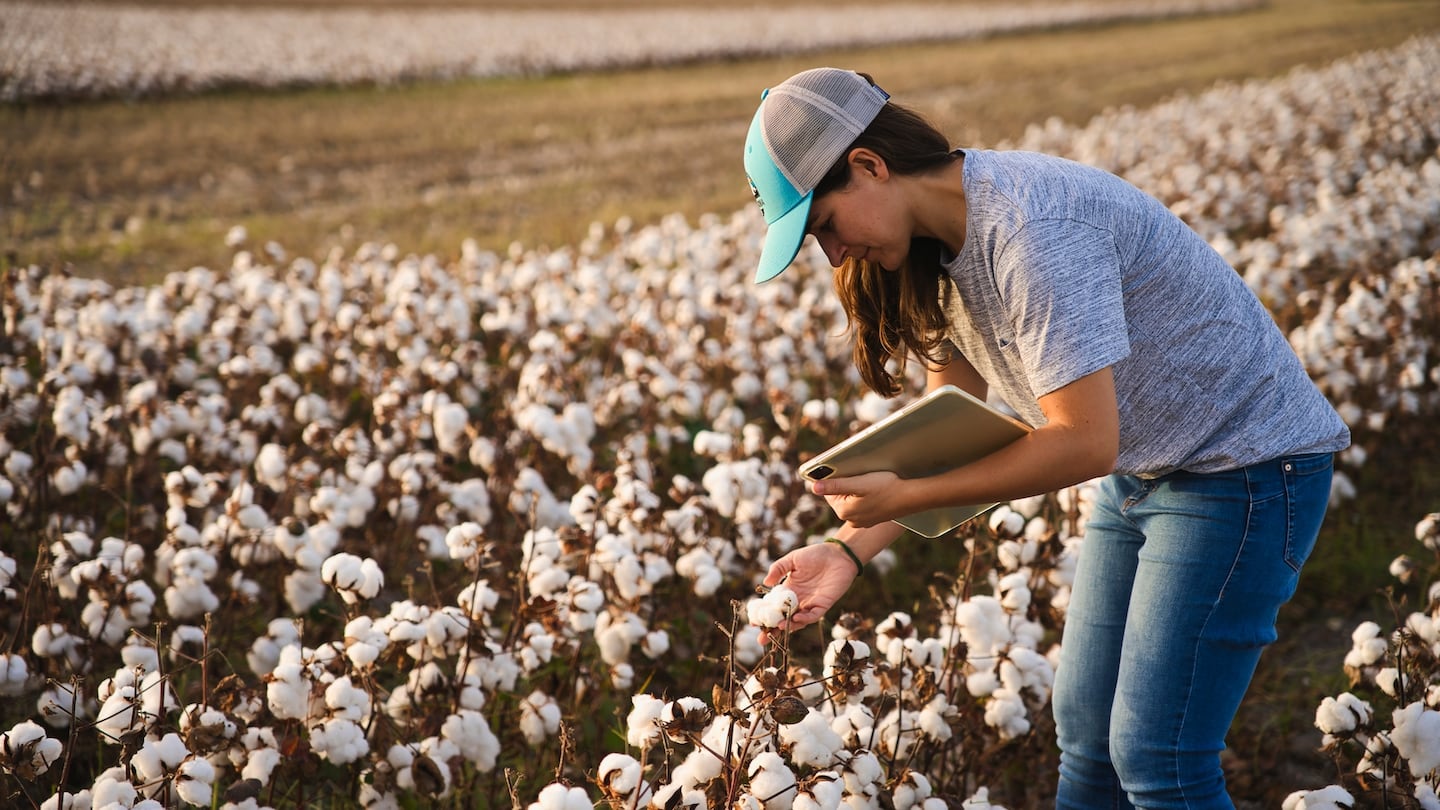
The Business of Fashion
Agenda-setting intelligence, analysis and advice for the global fashion community.

Agenda-setting intelligence, analysis and advice for the global fashion community.

Recognising the climate risks posed by emissions generated in their value chain, many of the largest brands and retailers in the US have signed on to the Fashion Industry Charter for Climate Action. This charter supports the goal of reducing the industry’s carbon footprint by 50 percent by 2030 and achieving net zero emissions by 2050.
Fashion’s relationship with farming is comparatively under-explored in relation to other areas of the industry’s sustainability efforts, which is somewhat counterintuitive considering how critical natural material production is in evaluating the environmental impact of fashion’s supply chain. The scale is also enormous: each year more than 26 million tonnes of cotton alone is produced for the textile and apparel industries, according to Textile Exchange, a sustainable fibre and materials non-profit.
Looking to improve the environmental impact of cotton production, the US government launched the US Climate Smart Cotton Program. First announced in 2022, the programme will provide technical and financial assistance to 1,650 US cotton growers spanning 1.2 million acres of arable land, which represents 10 percent of the total acreage dedicated to cotton production in the US.
The Climate Smart Cotton Program encourages growers to drive positive change in order to reduce carbon emissions. The goal of its “collaborative pilot” is to produce 4.2 million bales of Climate Smart Cotton — each bale consisting of 480 lbs of product — over five years, thereby reducing CO2 emissions by 1.14 million metric tonnes across production.
By providing technical and financial assistance, the Climate Smart Cotton Program seeks to limit the monetary risk of innovating new solutions. Participating growers will receive three consecutive years of technical and financial assistance to support the adoption of climate-smart agriculture practices, which is enough time for them to experience evidence of greenhouse gas (GHG) reductions, cost reductions and soil health benefits.
To lead the Climate Smart Cotton Program, the US government provided a grant to the US Cotton Trust Protocol — a voluntary, farm-level, science-based sustainability programme, setting a new standard in sustainable cotton production. In order to apply for the Climate Smart Cotton Program, growers must first be members of the Trust Protocol.
To discover more about the Trust Protocol’s leadership of the Climate Smart Cotton Program, the future of cotton agriculture and the challenges in driving sustainable innovation, BoF sits down with Daren Abney, executive director of the US Cotton Trust Protocol.

Over the last decade, we have seen a significant shift from brands and retailers who are now re-evaluating their raw material strategy as a whole, in order to gain a broader understanding of the environmental and social impact of the materials they so heavily rely on.
Now, we are moving into this phase where regulation is starting to push into the purview of retailers and brands. It is not simply a nice-to-have from a consumer perspective nor is it purely a need from a business perspective — it’s an overarching imperative to continue functioning. So, tapping into raw material sources that are produced more sustainably is something that we have seen grow exponentially.
However, this can be a challenge for brands and retailers because of the intricate nature of the textile supply chain. From farm to brand, it typically takes 12 to 15 steps from the raw material coming from the field to the store shelf. In the past, more sustainable materials were sourced for small capsule collections that were designed as consumer engagement strategies, rather than as the evolution of their supply chains. But that is changing.
There is good access to technology in US agriculture, which has brought about a lot of improvements like resistance to drought and more efficiency in terms of soil management. At a holistic level, practices that are commonly referred to as regenerative are becoming more prevalent within the cotton-grower community in the US each year. We are only in the early stages of implementing the Climate Smart Cotton Program, but we have some bold goals around it.
We have been asked before if the US Cotton Trust Protocol is a regenerative cotton standard and right now, there is no formal regenerative certification at scale. New programmes are popping up, but “regenerative agriculture” often describes farming practices that are meant to address climate change by rebuilding soil organic matter and restoring soil biodiversity, which can result in carbon drawdown and improve the water cycle. These practices can also increase productivity and naturally reduce the need for external inputs like fertiliser — essentially using nature to combat nature.
We want to reduce CO2 emissions by 1.14 million metric tonnes over the course of the grant, which is equivalent to 4.2 million bales of Climate Smart Cotton through these practices.
We are seeing strong progress as our grower members implement practices that are considered regenerative. Last year, 55 percent of Trust Protocol acres were planted with cover crops and 70 percent practiced crop rotation. Furthermore, more than half of reported acres practiced no-till and 30 percent practiced reduced tillage.
All these techniques play a part in the regenerative approach in the regionally relevant context of cotton growing. It’s impossible to say cotton equals X impact, as it depends on what lens you are looking at, like seasonal weather patterns or the location you are growing in. What we focus on is equipping growers to be able to make decisions that improve the productivity of their land, the environmental health of their land and the conditions for people that are working on it.
The measurement of data is really the next frontier. A lot of the data and decisions that have been made in the past about textile sustainability have been based around life cycle assessment (LCA) modelling — a methodology used for measuring the environmental impacts of materials and products, including greenhouse gas emissions.
Measuring the environmental footprint of cotton production at the field level, as well as providing our members with a fully traceable supply chain system, is the imperative that we are looking to lead in that space going forward. So, we provide year-on-year data. That means Trust Protocol growers can see what they are doing live, year-over-year, as well as providing that information in aggregate to the market.
As a field-level programme, we are focused on the field-level impacts for growers and the environment.
It’s incredibly important yet incredibly difficult. As a field-level programme, we are focused on the field-level impacts for growers and the environment. The programme is the only system providing quantifiable, verified goals and measurements that ultimately drive continuous improvement in the six key sustainability metrics: land use; soil carbon; water management; soil loss; and then greenhouse gas emissions and energy efficiency.
Trust Protocol growers have already seen progress in reducing their GHG emissions. Against 2021 and 2022 data from the Trust Protocol, growers achieved a 25 percent reduction in energy use and a 21 percent in GHG emissions when compared to our 2015 baseline. What’s more, we disclosed that our growers had increased water efficiency by 14 percent while soil loss was reduced by 78 percent, which we view as great progress.
The Trust Protocol is the lead of a five-year initiative aimed at measuring and improving the carbon footprint of the US cotton industry, built on three pillars of climate-smart agriculture practices including cover crops, reducing tillage and nutrient management plans, all of which increase biodiversity and improve the health of the soil. We want to reduce CO2 emissions by 1.14 million metric tonnes over the course of the grant, which is equivalent to 4.2 million bales of Climate Smart Cotton through these practices.
US cotton growers are typically not mono-cropping — cotton is a rotational crop. That is key for soil health and sometimes a response to a seasonal weather pattern. The cotton growers in the programme take a whole farm approach when they are thinking about regenerative agriculture practices and core to that is biodiversity — cotton farming in an inclusive manner, rather than operating through mutually exclusive or even competing approaches.
What we are looking at is enabling the best practice and economic outcomes for these growers to understand if implementing practices like minimal tillage or cover crops is right for their farm.
Being willing to try different methods in different fields is embraced by our cotton growers, which I think leans back to us being the lead recipient in the Climate Smart Grants Program. It is about minimising soil disturbance and loss and maintaining year-round living roots, as well as keeping that soil covered up so that you can maximise crop diversity.
Over the last four decades, we have documented proof that US cotton growers have used 79 percent less water, 54 percent less energy and reduced greenhouse gas emissions by 40 percent. So, we now have metrics as a cotton-growing community and as we continue that measurement and expand our impact, we can track our progress in relation to climate change and the need to adapt to a changing world.
Cotton is the natural fibre most widely used in the textile industry and the US is the third largest cotton-growing country in the world. The Trust Protocol has 1.7 million acres of planted US cotton that are now enrolled in the programme across 17 different cotton-producing states in the southern belt of the US.
It’s important to understand too that regional context for something like a sustainability programme so it will allow for adaptability and variations across geographical landscapes. Cotton that is grown in California compared to Texas compared to Georgia will look dramatically different based on the soil, the elevation, the pest threat, the weather patterns for that year, among other contributing factors.
What we are looking at is enabling the best practice and economic outcomes for these growers to understand if implementing practices like minimal tillage or cover crops is right for their farm. What are the economic benefits for that grower to continue regenerative practices in a land that is going to ultimately be their livelihood?
So, 17 percent of the total US crop is under the US Cotton Trust Protocol Program and we have ambition to scale that in the near-term. I believe we have started generating some excitement among the community around some of the immediate financial benefits of adopting these practices.
This is a sponsored feature paid for by The US Cotton Trust Protocol as part of a BoF partnership.
The US Cotton Trust Protocol works with cotton growers to produce fibres with a lower environmental and social risk in alignment with the UN’s Sustainable Development Goals for members like Levi’s and Gap Inc.
The State of Fashion 2024's essential guide to incoming sustainability regulation reveals how and why retailers, brands and manufacturers need to revamp business models to align to a shifting regulatory landscape.
Europe’s Parliament has signed off rules that will make brands more accountable for what happens in their supply chains, ban products made with forced labour and set new environmental standards for the design and disposal of products.
Fashion’s biggest sustainable cotton certifier said it found no evidence of non-compliance at farms covered by its standard, but acknowledged weaknesses in its monitoring approach.
As they move to protect their intellectual property, big brands are coming into conflict with a growing class of up-and-coming designers working with refashioned designer gear.
The industry needs to ditch its reliance on fossil-fuel-based materials like polyester in order to meet climate targets, according to a new report from Textile Exchange.